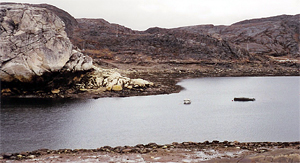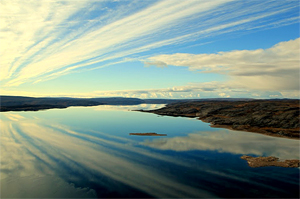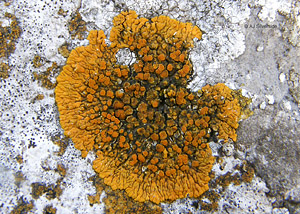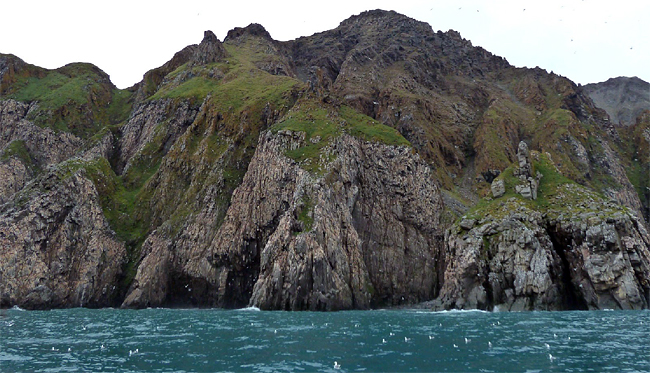 Thayer's Gull (thayeri)
Thayer's Gull (thayeri)
(last update: January 22, 2013)
Thayer's Gull adult November
below you will find part 2 of the paper: Hybridization and changes in the distribution of Iceland gulls
(Larus glaucoides/kumlieni/thayeri),
by D. N. Weir, A.C. Kitchener and R. Y. McGowan,
IN: J. Zool., Lond.(2000) 252, 517-530.
BACK TO PART 1: INTRO, DEFINITIONS & METHODS
"we" in the text below refers to the original authors. If any errors occur in this text, please let me know and mail to marsmuusseatgmaildotcom.
Hybridization and changes in the distribution of Iceland gulls
(Larus glaucoides/kumlieni/thayeri)
RESULTS
 Present breeding distribution
Present breeding distribution
Post-1950 breeding distributions of Iceland gull taxa are shown in Fig. 1. Distributions are much more clumped and discontinuous than can be shown at this scale (MacPherson, 1961; Joensen & Preuss, 1972; Gaston et al., 1986; A. J. Gaston, in litt.). The main southward thrust of thick, multi-year accretions of pack ice that block the Northwest Passage (Neatby, 1970) is shown with a southern boundary of the High Arctic (Bliss, 1977, in Sage, 1986). These indicate that present distributions are High Arctic for thayeri, Low to High Arctic for kumlieni and glaucoides, and that Iceland gulls are absent from the coasts most affected by thick ice. The range of kumlieni lies between those of thayeri and glaucoides, and kumlieni is sympatric with both.
Canada
It is usually thought that glaucoides as defined here no longer breeds anywhere in Canada (Snyder, 1957; MacPherson, 1961; Godfrey, 1966, 1986; Ingolfsson, 1967; Fjeldså & Jensen, 1985). However, the palest winged birds at 69°N in east Baffin Island were thought to be indistinguishable from glaucoides (Snell, 1989), and a few adult ‘Iceland gulls’ were found with breeding thayeri at 73°N (Reynaud, Johnson & Finley, 1981).
Kumlieni is found in variably-spaced colonies with the highest numbers in east Baffin Island, from Meta Incognita to Cumberland Sound, and with the palest winged birds in a minority (MacPherson, 1961; Fjeldså & Jensen, 1985; Gaston & Decker, 1985; Gaston et al., 1985, 1986; Snell, 1989; A. J. Gaston, in litt.). These sources estimated numbers of kumlieni for the Foxe Basin coasts, south Baffin Island and part of east Baffin Island, and more recent information for other potential range within these limits was added, suggesting a total Canadian breeding population of 10 000 pairs ±50%. Possibly no kumlieni breed west of Southampton Island (A. J. Gaston, in Snell, 1989), although there were at least three 1930s to 1950s records of kumlieni as defined here from thayeri colonies further north or north-west (Bray & Manning, 1943; Manning et al., 1956; Parmalee & MacDonald, 1960). The boundary between kumlieni and thayeri in northern Hudson Bay and Hudson Strait does not seem to have shifted in the last 20 years (A. J. Gaston, in litt.). Nor did that in Home Bay, east Baffin Island, between 1960 and 1987 (Smith, 1966; Snell, 1989).
Numbers of thayeri range from relatively many, large colonies in south-western Foxe Basin to few, small colonies on the northernmost breeding islands (Ellis, 1956; Ellis & Evans, 1960; Manning et al., 1956; Tuck & Lemieux, 1959; Parmalee & MacDonald, 1960; MacPherson, 1961; Savile, 1961; Parmalee, Stevens & Schmidt, 1966; Nettleship, 1974; Gaston et al., 1986; Godfrey, 1986; Snell, 1989). The most recent information suggests a Canadian population of 4000-6000 pairs, with highest numbers in the Frozen Strait/Lyon Inlet area (Smith, Whitney & Storm, 1995; Smith, Saunders & Whitney, 1996). There are few very recent data for the mainland coast west of c. 90°W.
In east Baffin Island there may have been a gap between the southern limits of thayeri and northern limits of kumlieni, but the present southern limits of thayeri were correctly predicted by MacPherson (1961), and determined by Smith (1966).
Greenland
The distribution of glaucoides shown in Fig. 1 is from Salomonsen (1979a); see also Evans (1984). Recent local declines in west Greenland were attributed to overshooting (Salomonsen, 1967). Northern limits in east Greenland may be further south than in Fig. 1 (Boertmann, 1994; J. Fjeldså, in litt.). Evans (1984) gave no estimate of the breeding population, but it may be less than 80 000 pairs (Boertmann, 1994).
The current breeding population includes unknown numbers of probably widespread kumlieni. Different samples of 10 and five June-July adult specimens were all glaucoides (Fjeldså & Jensen, 1985; Weir et al., 1995), but 12 of 19 (63%) from June-August had some wingtip melanism, which was very subdued in nine (Ingolfsson, 1967). Many of the same specimens were examined by Ingolfsson (1967) and Fjeldså & Jensen (1985), so that most of Ingolfsson's summer kumlieni must have been from August rather than June-July, and were treated as taken after the breeding season by Fjeldså & Jensen. More recently there were a further five specimens or sight records of summer adults with evident wingtip melanism (Olsen, 1991; Boertmann, 1994). Some of the above birds presumably bred, and there was a definite record from Søndre Strømfjord in west Greenland in 1964 where chicks taken into captivity developed subdued wingtip melanism and olive-brown or olive-buff irises when adult (Goethe, 1986). Many pale-winged kumlieni are indistinguishable from glaucoides in the field (Fjeldså & Jensen, 1985), and Goethe (1986) did not mention adult kumlieni, although he made prolonged observations at the colony where he took the chicks. Pale-winged kumlieni may often be overlooked in Greenland.
Salomonsen (1967) gave a very restricted distribution for thayeri. Breeding birds were not found in west Greenland by Thing (1976, contra Evans, 1984), but seven adults and fledged young were seen just south of the breeding area in August 1987 (Olsen, 1991). A few summer adults were seen both coastally and at sea north and south of the breeding area (Brown, 1986; Boertmann, 1994).
Past breeding distribution
|
Distribution data to c. 1900 and 1950 are shown with selected dates of first records in Fig. 2 and Fig. 3. Up to c. 1900 both thayeri and kumlieni were known only from very small ranges, with thayeri only in the northwest of the present range. Even up to c. 1950, known ranges of both were smaller than now. However, travel to many breeding areas of both taxa remains very difficult to the present day. Thus the concentration of thayeri in Frozen Strait/Lyon Inlet was only found in the last decade, but extensive development of Caloplaca lichens suggests that gull colonies have used the cliffs for a long time (A. J. Gaston, in litt). The range of glaucoides before 1900 extended far into High Arctic Canada, where it was sympatric with thayeri. The apparent range expansion of thayeri as shown in Figs 1-3 corresponds partly in space and well in time to the known range contraction of glaucoides. In specific areas thayeri replaced glaucoides, probably in south-east Victoria Island, and certainly in Bellot Strait and the north-east coast of Prince Regent Inlet.
Canada
Iceland gulls and herring gulls were looked for from the earliest RN Arctic explorations (E. Sabine, 1819, 1824; MacGillivray, 1824; J. Sabine, 1824; Richardson, 1825, 1831, 1836; Ross, 1826, 1835). Extant specimens and early descriptions prove or suggest the identities of gulls at 14 locations from 10 explorations in 1818-59 (Table 3). The data refute two subsequent assumptions: firstly, that glaucous gull L. hyborboreus or thayeri were mistaken for glaucoides (Taverner, 1933; Salomonsen, 1950; MacPherson, 1961; Parmalee et al., 1966); and secondly, that all 'herring gulls' at high latitudes were thayeri (Dwight, 1925; MacPherson, 1961). Early identifications were mostly accurate despite assumptions by some later workers. Besides the specimen records, the best evidence for Canadian glaucoides was from the Parry Isles in 1819-20 and Prince Regent Inlet in 1829-32, the second and fifth voyages listed in Table 3.
The Canadian glaucoides colonies in Fig. 2 were spread over a large area, but glaucoides was definitely recorded in only four of the 10 explorations in Table 3 and might then have been scarce in Canada. In three publications from Parry's first voyage (1819-20) there were more than 20 references to glaucous gull in Canada, compared with only two for Iceland gull (Griffiths, 1821; E. Sabine, 1821, 1824).
Dark-winged gulls collected at six locations (Table 3) were, or probably were, smithsonianus. The first thayeri specimens from two areas and a record inferred from present distribution in a third, were from the north-west of its present range and from the first three voyages in the search for Sir John Franklin, which explored widely the western Canadian High Arctic (Neatby, 1970). Evidence that thayeri then bred east of 90°W or south of 70°N was lacking, but the early explorers did not reach important breeding areas (see above).
Many other early records lack specimens or descriptions. We traced specimens of eggs of ‘Iceland gulls’, taken for USNM in 1861-65 on the lower Anderson River east of the Mackenzie Delta MacFarlane, 1891). The ‘Iceland gull’ eggs were thought to be of the small barrovianus race of the glaucous gull (Taverner, 1933) and the 18 extant sets of MacFarlane's eggs in the USNM (14) and NMS (four) are all now regarded as glaucous gulls (R. Schmidt, in litt.; this study). A very pale adult specimen of the Iceland gull breeding near the Digges Isles in 1886 was lost (Feilden, 1889). It might have been either glaucoides or pale kumlieni; most Digges Sound birds now are typical kumlieni, but range from birds with heavily pigmented wingtips to almost unpigmented (Gaston et all., 1985; A. J. Gaston, in litt.). A similarly pale and probably breeding adult female from Cape Chidley, north Labrador, in 1934 was identified as leucopterus (=glaucoides) at MCZ (Gross, 1937). We have not examined it, but Snyder (1957) gave the range of kumlieni as extending to Cape Chidley, possibly from this record.
|
Although the first breeding kumlieni recorded at Cumberland Sound, east Baffin Island in 1878 had evident wingtip melanism, ‘white-winged’ adults also were present, but not breeding (Kumlien, 1879). Apart from Digges Sound (see above) no other colony was reported in the nineteenth century, but those two areas are near the western and northern limits of the present range (Fig. 1). An increasingly wider breeding range in and near Baffin Island was reported in the middle part of the twentieth century (Taverner, 1933; Soper, 1940, 1946; Rand, 1942; Wynne-Edwards, 1952; Snyder, 1957). Range limits in Snyder (1957) are exceeded in most directions by present limits (Fig. 1). This most likely resulted from increased knowledge, but major twentieth century range expansion cannot be wholly discounted (A. J. Gaston, in litt.).
The type series of thayeri is mainly summer adults from south-east Ellesmere Island collected in 1901 (Brooks, 1915). ‘Kumlien's gull’ eggs collected by J. S. Warmbath from south-east Ellesmere Island in 1900 were assumed to be thayeri (Bent, 1921), but earlier field descriptions of two adult ‘stragglers’ there fitted glaucoides (Greeley, 1886). No dark-winged gulls or Iceland gulls were recorded there by Feilden (1877; 1879b).
Subsequent determination of the range of thayeri was complicated by debate over its status and over the identity of many specimens (Dwight, 1917, 1925; Taverner, 1933; Rand, 1942; Synder, 1957; MacPherson, 1961). Dwight (1925) stated that there was a clinal transition from smithsonianus to thayeri north and west from Hudson's Bay. The two taxa were shown as narrowly allopatric by Snyder (1957); birds in Foxe Basin south of those limits had all been described simply as ‘herring gulls’ (Bray & Manning, 1943). To summarize past and recent Canadian data, thayeri was known only from the north-west of its present range until c. 1860, to present north-east limits by 1900, to present southern limits in Foxe Basin by 1960 (Smith, 1966) and to those in east Baffin Island by 1960. Again, increased knowledge is suspected to account for its presence at Foxe Basin and Baffin Island (A. J. Gaston, in litt.), but in some northern areas thayeri replaced glaucoides (see above).
|
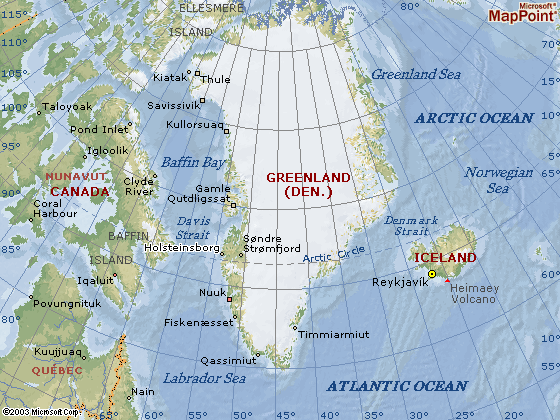
Greenland
According to Winge (1898), the earliest reference to the Iceland gull was in a publication of 1771; the Inupik name for the Iceland gull differed from two for the glaucous gull, and the Inuit still distinguish by name between freshly killed breeding adults of the two species by the colour of the orbital ring (Freuchen & Salomonsen, 1957). In the 1820s, locations for type descriptions of glaucoides or synonyms were mostly from west Greenland coasts or waters (Salvin, 1896), but MacGillivray (1824) described a large adult given to the Edinburgh Museum by Captain Scoresby from his voyage to east Greenland. The specimen seems to have gone missing by 1860 (NMS Archives) but is by far the earliest east Greenland record.
In those parts of west Greenland known to Europeans, i.e. from Cape Farewell to 73°N, breeding Iceland gulls were widespread and common (Reinhardt, 1861; Hagerup, 1891; Winge, 1898). In adult specimens from west Greenland in ZMK there were no plumage differences between 15 Iceland gulls and 10 glaucous gulls (Winge, 1898). Slight melanism on the wingtips of glaucous gulls is extremely rare in west Greenland specimens (Ingolfsson, 1993), suggesting that the Iceland gulls were all glaucoides as defined here. Moreover, all remaining adult Iceland gulls in ZMK which Winge could have included in his sample are glaucoides (J. Fjeldså, in litt.).
Early records of adult Iceland gulls in the High Arctic of Greenland and Canada were thought to be misidentified glaucous gulls (Taverner, 1933; Salomonsen, 1950) but Table 3 refutes this for records up to 1859. We did not re-examine all records which Salomonsen rejected, but he rightly rejected those of Nares (1878) whose expedition naturalist did not mention Iceland gulls (Feilden, 1877; 1879b).
Iceland gulls were said to breed to c. 73°N in west Greenland in the nineteenth century (see above) and present limits are c. 72°N (Joensen & Preuss, 1972; Boertmann, 1994). Two clutches of eggs were taken there at almost 75°N in 1934 (Dalgety, 1936). Comparison of Dalgety's egg measurements with those in Makatsch (1974) confirm them as Iceland gull eggs. Northern limits may have changed little in west Greenland. The distribution of many bird species in east Greenland remains poorly known (Boertmann, 1994) and there is no consensus on the present northern limits of Iceland gulls there (see above). A breeding record north of 75°N (Pedersen, 1934) was further north than any ever recorded and is highly doubtful (Lùppenthin, 1932; Salomonsen, 1950, 1979a; Elander & Blomqvist, 1986; Boertmann, 1994; J. Fjeldså, in litt.).
A gull from west Greenland with subdued wingtip melanism was named L. chalcopterus by Lichtenstein in 1854. Wingtip melanism of the specimen was not evident to Dwight (1906, 1925) nor to Salvin (1896), who thought this might be due to poor lighting in the Berlin Museum. Moreover, Holboell saw three similar specimens in west Greenland about the same time (Reinhardt, 1861). Some observers looked for summer adult kumlieni in west Greenland as soon as the taxon was described (Hagerup, 1891), but the first published records were from the 1980s (Olsen, 1991; Boertmann, 1994). However, we note a breeding record for the 1960s (Goethe, 1986) and summer specimens examined by Ingolfsson (1967) must have included birds which were taken some or many years earlier.
The first summer adult thayeri was taken just south of the breeding area in 1914 and about six more records up to 1939 included eggs (Salomonsen, 1950). The early naturalists had looked unsuccessfully for dark-winged gulls off north-west Greenland (E. Sabine, 1819, 1824; Walker, 1860b; Feilden, 1877, 1879b).
END OF PART 2
 Thayer's Gull adult, November 24 2013, Lake County, IL. Picture: Amar Ayyash.
Thayer's Gull adult, November 24 2013, Lake County, IL. Picture: Amar Ayyash. Thayer's Gull adult, November 24 2013, Lake County, IL. Picture: Amar Ayyash.
Thayer's Gull adult, November 24 2013, Lake County, IL. Picture: Amar Ayyash. Thayer's Gull adult, November 07 2010, Duluth/Superior, Wisconsin. Picture: Karl Bardon.
Thayer's Gull adult, November 07 2010, Duluth/Superior, Wisconsin. Picture: Karl Bardon. Thayer's Gull adult, November 23 2012, Lake County, IL. Picture: Amar Ayyash.
Thayer's Gull adult, November 23 2012, Lake County, IL. Picture: Amar Ayyash.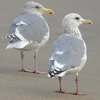 Thayer's Gull adult, November 18 2004, Rio del Mar, CA. Picture: Jeff Poklen. THGU (right) with presumed GW x WEGU, both basic adults. Note especially differences in head shape and bill size.
Thayer's Gull adult, November 18 2004, Rio del Mar, CA. Picture: Jeff Poklen. THGU (right) with presumed GW x WEGU, both basic adults. Note especially differences in head shape and bill size. Thayer's Gull adult, November 23 2008, Rio del Mar, CA. Picture: Jeff Poklen.
Thayer's Gull adult, November 23 2008, Rio del Mar, CA. Picture: Jeff Poklen. Thayer's Gull adult, November 30 2011, Duluth, Minnesota, US. Picture: Karl Bardon. Thin crescent of black on P5 and broken band on P10. Thayeri pattern on P9 combined with broad sub-terminal band.
Thayer's Gull adult, November 30 2011, Duluth, Minnesota, US. Picture: Karl Bardon. Thin crescent of black on P5 and broken band on P10. Thayeri pattern on P9 combined with broad sub-terminal band.  Thayer's Gull adult, November 24 2011, Duluth, Minnesota, US. Picture: Karl Bardon. Last phase of complete moult, P10 growing. No black on P5 and broken band on P10. Thayeri pattern on P9 combined with broad sub-terminal band.
Thayer's Gull adult, November 24 2011, Duluth, Minnesota, US. Picture: Karl Bardon. Last phase of complete moult, P10 growing. No black on P5 and broken band on P10. Thayeri pattern on P9 combined with broad sub-terminal band.  Thayer's Gull adult, November 23 2008, Canal Park, Duluth, MN. Picture: Erik Bruhnke.
Thayer's Gull adult, November 23 2008, Canal Park, Duluth, MN. Picture: Erik Bruhnke.